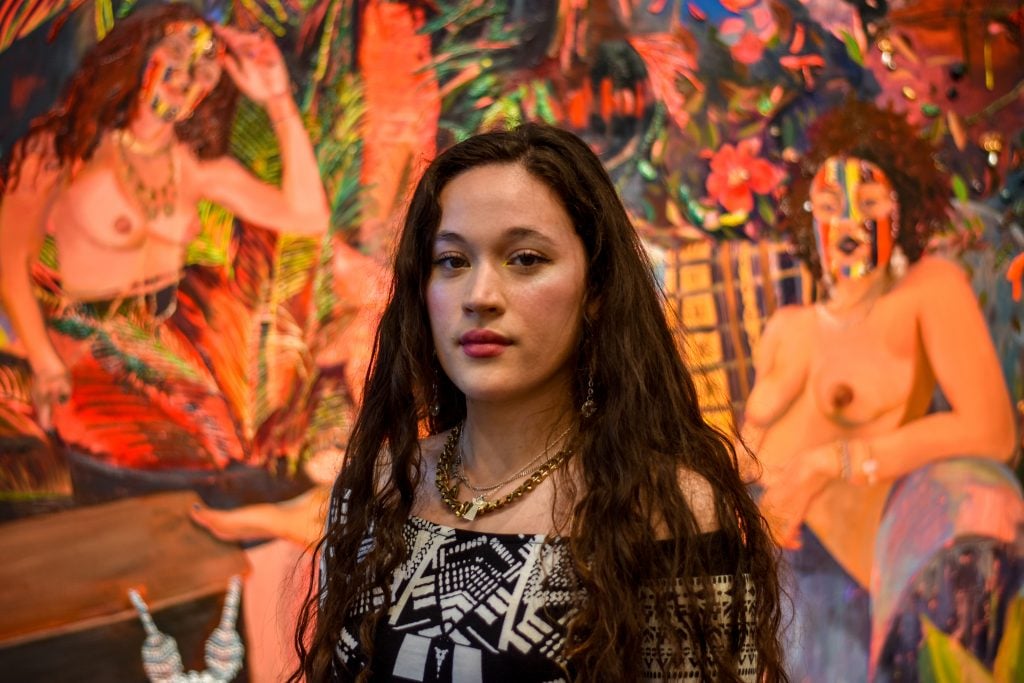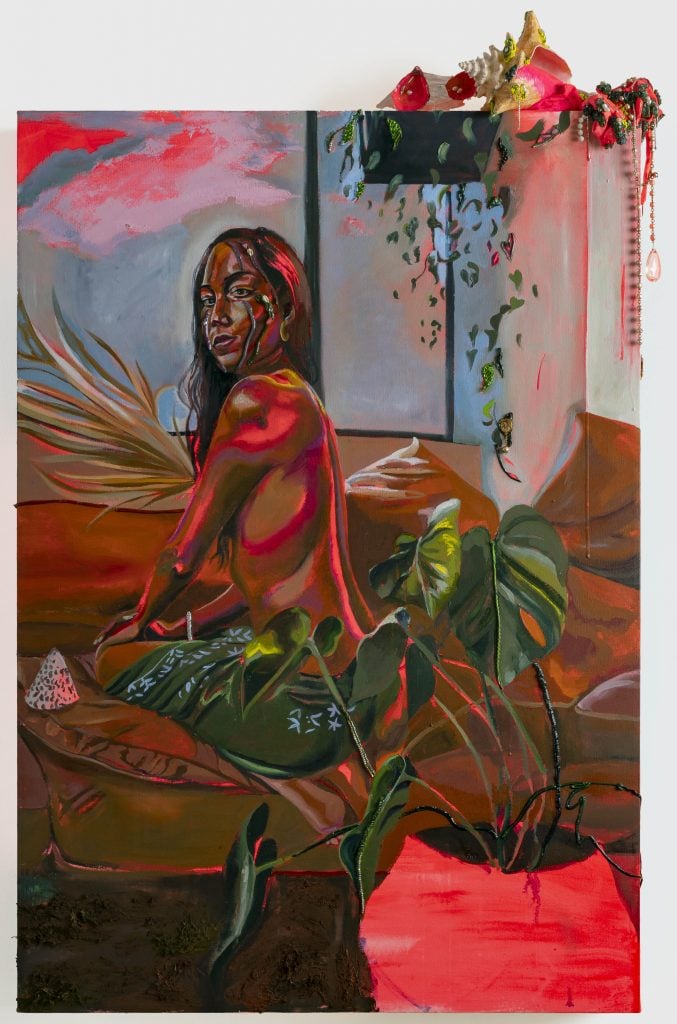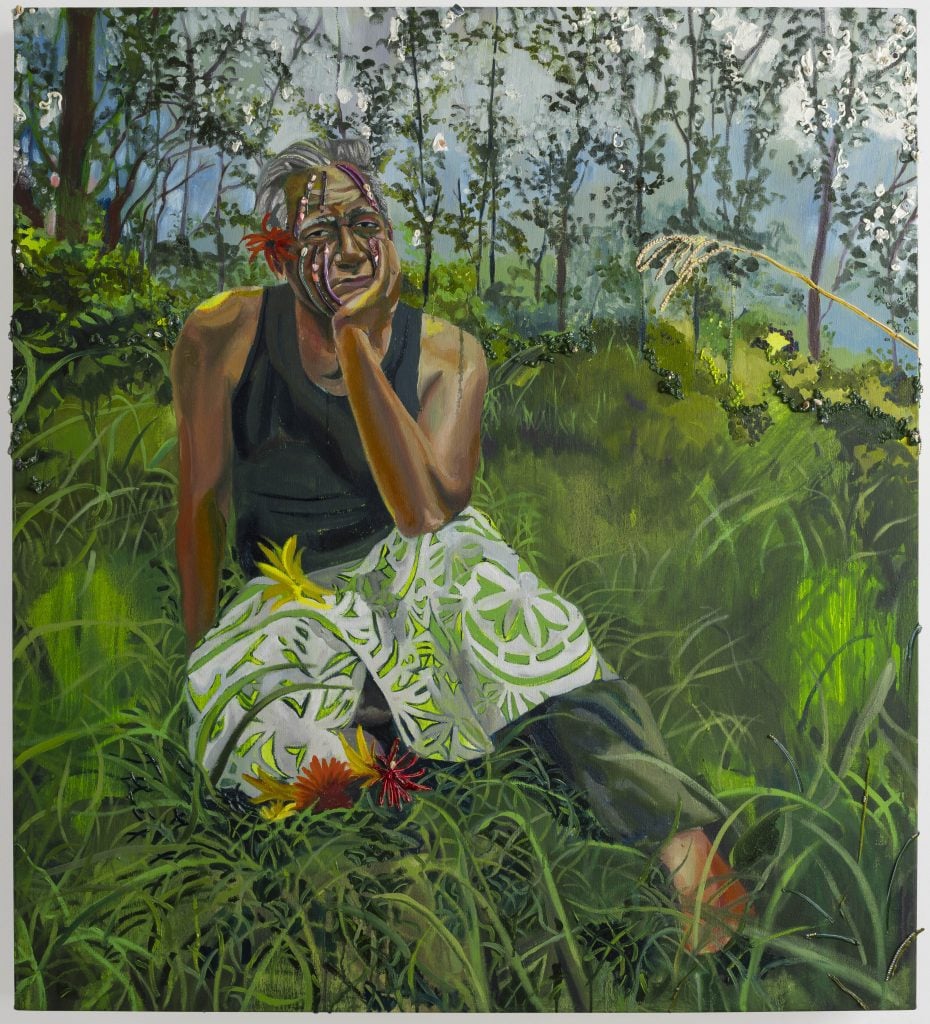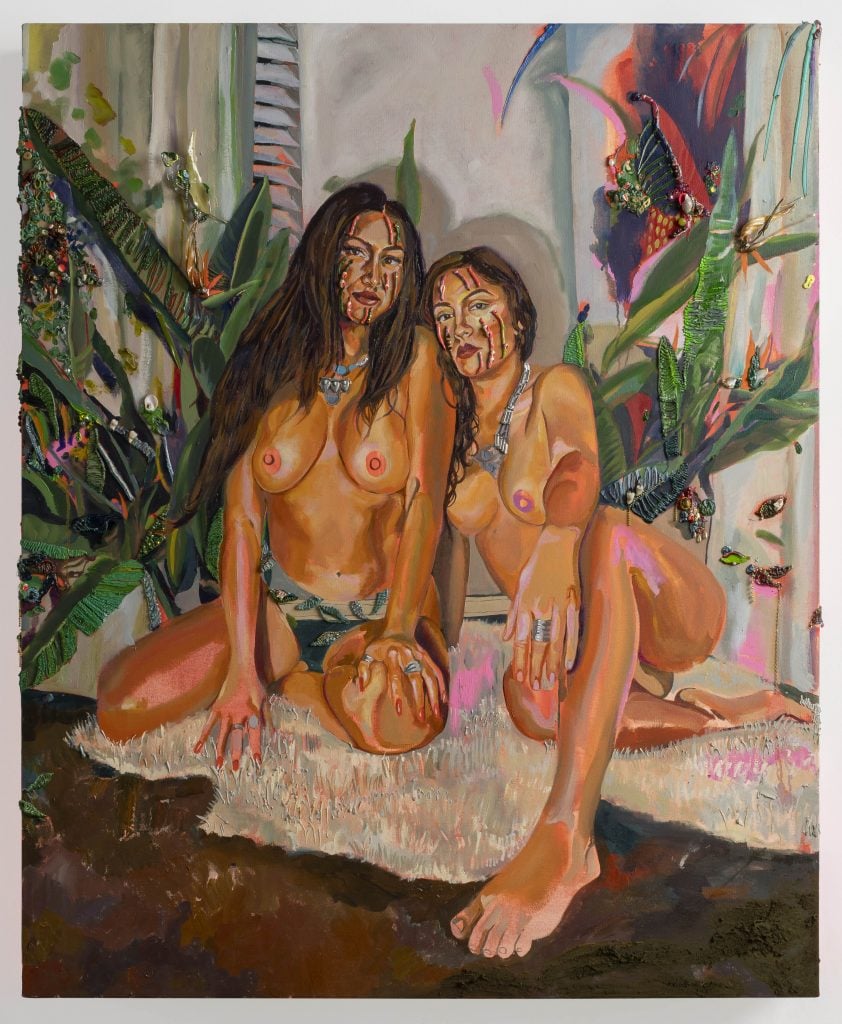People
‘I Want to Replace Gauguin’s Work:’ How Chamorro Painter Gisela McDaniel Gives Survivors of Trauma a Voice With Her Empowering Portraits
We spoke with the Detroit-based artist ahead of her new solo show in London.

We spoke with the Detroit-based artist ahead of her new solo show in London.

Julie Baumgardner

On paper, Gisela McDaniel is poised to be the type of young artist who will explode on the market, with soaring auction results and impossible waiting lists. Except, the 25-year-old Detroit-based Indigenous Chamorro painter, won’t let that happen.
McDaniel resists certain art world conventions, whether it be the history of painting or how collectors and institutions can acquire her work. Her canvases push formalist concerns, as much as topical and metaphysical ones, in a compelling direction that’s deeply intimate and affecting. McDaniel’s portraits of trauma survivors depict immensely sympathetic subjects in emotional and resplendent tableaus, with built-in recordings of her sitters sharing their stories.
Artnet News caught up with McDaniel ahead of her second show at London gallery Pilar Corrias, “Manhaga Fu’una” opening Thursday, January 27.
Tell us a little bit about your background.
I was born in Bellevue, Nebraska on a military base. A lot of my family members have been in the US Navy. Guam is a military space, a lot of the job options are joining the Navy. There’s a big Chamorro diaspora around US military bases, specifically in San Diego. So, that is something my grandfather did to support his family. But I didn’t grow up on the island, I didn’t have the experience of living on that land on a day-to-day basis.
At the same time, my ancestors and my Chamurro values are incredibly important to me, in the way I work and move. Even the way I work with other people, the foundation of everything is respect. Respect is one the biggest values in our culture, especially in regards to our elders, first and foremost, but it also applies to everybody.
I think about Indigeneity and the parts of it that I’m comfortable sharing with the art world. The way I’ve navigated that is by using value systems, applying them to every relationship I have and upholding my values in it, and how I’m comfortable with this work existing in the world, and ultimately being viewed and consumed.

Gisela McDaniel, Inagofli’e (2021). Courtesy of the artist and Pilar Corrias, London.
When I look at your work, I see that you are subverting traditional colonial and European perspectives, by not reducing your subjects to muses. Or by literally giving voice to your subjects and incorporating objects of their personhood, which are tangible extensions of their identity, in your portraits. Do you see it that way too?
I see my work in layers: the first layer is the relationship I have with the person, and the last layer is this protective voice to make sure they can speak for themselves. A lot of the ways I make work are protective.
Many of the people in the paintings have difficult but important stories that other people need to hear. They’ve been erased historically. With every single person, I ask for permission every step of the way, especially when I’m painting somebody. I can’t expect that back, but I hope when people experience my work, they walk away from it with a kind of awareness to move around people with respect. That’s a big reason I incorporate voice.
I’m gifted these stories. I get to learn about the stories. I hope I can treat them as if they’re precious, because they are. If we don’t record these stories, then they’ll be lost.

Gisela McDaniel, Måmes (2021). Courtesy of the artist and Pilar Corrias, London.
How do you instilling your values into your work?
These aren’t things I create because I want it to be a marketable artist. These are things I create because they’re what I needed to heal all the trouble that living in this vessel has been. I realized I could do that for other people. There’s so many things we need to talk about and for me to control the narrative—pick who I get to paint—I’m navigating this line of being grateful and happy to be in the room.
But these paintings are also objects. I have trouble with that. I don’t want them to be just objects. They’ll never just be objects to me. When I look at the paintings, I’m taken back to that moment with that person.
I have an agenda with this work. I love painting, I’m so grateful I get to paint everyday, but this is so much more than that to me. A lot of the pressure I put on myself isn’t necessarily to be “successful,” but to make sure that I’m doing right by my people and the people I work with.
You’ve mentioned Paul Gauguin before in interviews. I’m curious what your relationship to Gauguin is. Are you trying to flip the script, perhaps to show the other side of that art history?
I think about him all the time. I remember seeing his work my whole life—my mom took me to art museums, and she always hated him. Ever since I was little, I saw art as history. I would see Gauguin’s pieces, and wonder who those people were, what their stories were, and always feel frustrated.
That’s kinda where that started. I was always attracted to the colors. I had professors tell me, “Oh, you’re using Gauguin’s palette.”
When I see his work, I sit back and see how others respond to it. It felt like a second wave of tourism and exotification. There’s always a crowd around it, people taking photos and then walking away. It never felt like those were his colors or his people to paint. Then you learn about his relationships, and his book Writings on the Savage—sometimes I’ll skim it if I need motivation because it’s so awful. It’s so funny to see his work still celebrated. I even follow the hashtag on IG, and it’s funny to see how people post about the work in a celebratory way. I do not feel a celebration when I see his work, if anything. My heart drops.
I thought, “I’m going to reclaim his palette, and I’m going to take this back.” But, I also don’t want to reclaim it, because it was never his. I want to replace his work. I would love to see it gone. The wounds and harm he created, how can I fix that and put something made with more intention in its place?

Gisela McDaniel, Chelon Tiha (2021). Courtesy of the artist and Pilar Corrias, London.
Do you ever worry about being exploited in the marketplace? What are your experiences navigating that?
I keep saying the word, navigate, and I think about how my ancestors navigated the oceans. They were sailing the oceans just using the stars. The ocean is something I respect. The world is a tumultuous place, so to keep my head up and navigate with grace, I respect the people I work with, and make sure the people that I paint, my collaborators, they’re taken care of first.
I can paint, I can talk to people, I can do this sort of social practice, but beyond that, how can this work actually create change? I can’t control what someone is going to take away from the piece, but I can control what they see, hear and experience.
I think a lot about how survivors have to move around the world, the way we navigate in ways that people outside that experience would never know. There are a lot of reasons why people are survivors. It’s not just sexual violence. It’s also colonization, generational traumas.
As survivors, we need to heal, but the other side needs to heal and grow too. I’m all about what action sparks from this work and I love the opportunity to talk. That doesn’t mean I’m going to be best friends with someone who harmed me. But to let them know the other side of the perspective, that’s such a gift and opportunity for people to grow and heal.